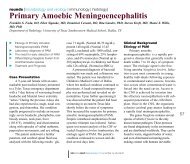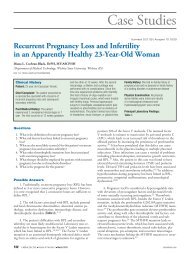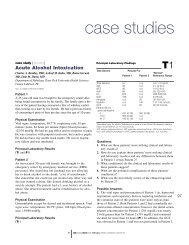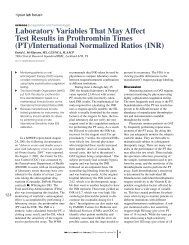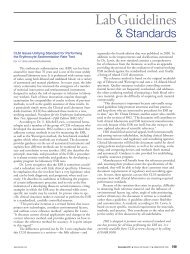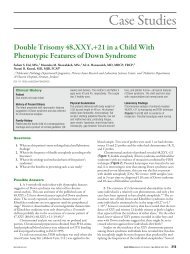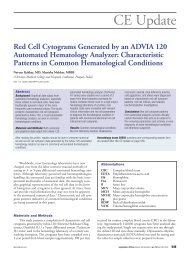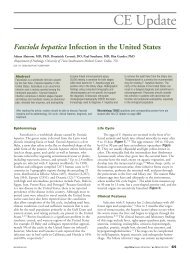Criteria for Blood Smear Review
Criteria for Blood Smear Review
Criteria for Blood Smear Review
You also want an ePaper? Increase the reach of your titles
YUMPU automatically turns print PDFs into web optimized ePapers that Google loves.
374<br />
�your lab focus�<br />
CE Update [hematology | blood banking/transfusion medicine | cytology | histology | chemistry]<br />
<strong>Criteria</strong> <strong>for</strong> <strong>Blood</strong> <strong>Smear</strong> <strong>Review</strong><br />
Gene L. Gulati, PhD, SH(ASCP)DLM, Mohammad Alomari, MD, William Kocher, MD, Roland Schwarting, MD<br />
Jefferson Medical College and Thomas Jefferson University Hospital, Philadelphia, PA<br />
After reading this article, the reader should be able to understand the who, what, where, when, and why of a blood smear review.<br />
Hematology exam 0201 questions and answer <strong>for</strong>ms are located after the “Your Lab Focus” section, p. 387.<br />
� <strong>Blood</strong> smear review is defined as a<br />
microscopic examination of an<br />
appropriately prepared and stained<br />
blood smear by a qualified<br />
hematomorphologist.<br />
� <strong>Blood</strong> smear review can serve as a<br />
quality control tool or as a means to<br />
assess competency of the technical<br />
staff.<br />
Complete blood count (CBC) and<br />
white cell differential (diff) are the 2<br />
most frequently per<strong>for</strong>med<br />
hematologic tests in the clinical laboratories.<br />
Automated hematology analyzers,<br />
when appropriately calibrated,<br />
generate reliable results <strong>for</strong> both of<br />
these tests on many blood specimens.<br />
The results of a significant proportion<br />
of specimens are flagged by the analyzers,<br />
however, and require confirmation<br />
by other techniques. One of these<br />
techniques is the microscopic examination<br />
of blood smear, generally<br />
known as “manual diff.” The number<br />
of manual diffs per<strong>for</strong>med daily by<br />
clinical hematology laboratories of<br />
many tertiary care medical centers is<br />
quite large. Quality control of the<br />
CBC and automated diff is made easy<br />
and practical by the availability of<br />
commercial reference materials. In<br />
contrast, <strong>for</strong> the manual diff, a common<br />
means of quality control is the<br />
review of selected blood smears by a<br />
qualified individual. 1-3 This type of<br />
review meets the accreditation<br />
requirement of the Commission on<br />
Laboratory Accreditation (CLA) of the<br />
College of American Pathologists<br />
(CAP). The Commission on Laboratory<br />
Accreditation of the CAP requires<br />
each laboratory to have a list of crite-<br />
ria specific <strong>for</strong> blood smears that must<br />
be reviewed. 4 In this article, the authors<br />
discuss the issue of blood smear<br />
review and provide a list of review<br />
criteria which may be used as a guide<br />
by hematology laboratories.<br />
What Is a <strong>Blood</strong> <strong>Smear</strong><br />
<strong>Review</strong>?<br />
<strong>Blood</strong> smear review, <strong>for</strong> the purpose<br />
of this article, is defined as a<br />
thorough and careful microscopic examination<br />
of an appropriately<br />
prepared and stained blood smear by a<br />
qualified hematomorphologist. After<br />
verifying the quality of the smear and<br />
stain, the reviewer will examine the<br />
smear <strong>for</strong> clinically significant findings.<br />
All abnormalities should be<br />
noted, suspected as well as<br />
unsuspected, blood cells-related or<br />
otherwise. A complete examination<br />
should include observation under both<br />
low (x100) and high magnification<br />
(x500 and/or x1000).<br />
The morphology of all cellular<br />
elements is reviewed in addition to<br />
verification of the results obtained <strong>for</strong><br />
the CBC and differential. The end<br />
product is the confirmation or revision<br />
of the CBC and diff results. Additionally<br />
<strong>for</strong> new cases, a written report<br />
should be generated by a laboratory<br />
physician providing interpretation of<br />
hematologic and other available pertinent<br />
laboratory and clinical findings.<br />
Manual diff and blood smear review,<br />
while similar to each other, do differ<br />
in certain aspects.<br />
A manual diff does not include<br />
interpretation by a laboratory physician,<br />
whereas blood smear review<br />
does, especially <strong>for</strong> new cases. Man-<br />
laboratorymedicine> may 2002> number 5> volume 33<br />
©<br />
ual diffs are usually per<strong>for</strong>med on<br />
specimens that are either flagged by<br />
the automated analyzer or reveal significant<br />
abnormalities in the CBC or<br />
automated diff results; whereas blood<br />
smear reviews are per<strong>for</strong>med only on<br />
cases selected mainly <strong>for</strong> clinically<br />
significant findings in the CBC and/or<br />
manual diff. A manual diff, which is<br />
classified as a high complexity test by<br />
the federal government, may be per<strong>for</strong>med<br />
by an associate degree holder<br />
with an appropriate clinical laboratory<br />
training; whereas the blood smear review,<br />
according to the CLA of the<br />
CAP, must be per<strong>for</strong>med by a hematomorphologist.<br />
What Purpose Does the <strong>Blood</strong><br />
<strong>Smear</strong> <strong>Review</strong> Serve?<br />
Besides meeting accreditation requirement,<br />
review of blood smears by<br />
a well-trained and experienced<br />
hematomorphologist serves several<br />
functions that are essential to patient<br />
care. It serves as a quality<br />
control/quality assurance (QC/QA)<br />
tool <strong>for</strong> CBC, diff, and reticulocyte<br />
count results. It can be used to assess<br />
competency of the technical staff per<strong>for</strong>ming<br />
manual diffs. <strong>Blood</strong> smear<br />
review allows appropriate interpretation<br />
of CBC and manual diff data with<br />
other available laboratory findings and<br />
clinical in<strong>for</strong>mation. Such an interpretation<br />
may provide a definite diagnosis<br />
or suggest a strategy <strong>for</strong> additional<br />
work-up of the case in an efficient and<br />
cost-effective manner. Finally, it<br />
serves as an excellent hematology<br />
teaching resource <strong>for</strong> training students<br />
and staff, and in the continuing education<br />
of technical staff.
Proposed criteria <strong>for</strong> blood smear review (<strong>for</strong> adults)<br />
<strong>Criteria</strong> Initial <strong>Smear</strong>s Follow-up <strong>Smear</strong>s<br />
CBC<br />
WBC (x 10 9 /L or 10 3 /µL) >30 yes no<br />
HGB (g/dL) < 6 or >18 yes no<br />
MCV (fL or cmm) < 75 or >105 yes no<br />
MCHC (g/dL or %) > 36 yes no<br />
PLT (x 10 9 /L or 10 3 /µL) < 50 or > 999 yes no<br />
Differential<br />
Lymphocyte # (x 10 9 /L or 10 3 /µL) > 4.0 yes no<br />
Monocyte # (x 10 9 /L or 10 3 /µL) > 2.0 yes no<br />
Eosinophil # (x 10 9 /L or 10 3 /µL) > 1.0 yes no<br />
Basophil (%) > 4 yes yes<br />
Atypical lymph (%) > 10 yes yes<br />
Blasts (%) any yes yes<br />
Promyelocytes (%) > 3 yes yes<br />
Myelocytes (%) > 5 yes yes<br />
Metamyelocytes (%) > 10 yes yes<br />
Other abnormal or unidentifyable cells any yes yes<br />
NRBC (# per 100 WBC) > 2 yes no<br />
Organisms any yes yes<br />
Significant morphological abnormality of RBC, WBC, and/or PLT* yes no<br />
<strong>Blood</strong> <strong>Smear</strong> <strong>Review</strong> requested by clinician yes yes<br />
*Significant morphologic abnormalities:<br />
RBC (red blood cells):<br />
Anisocytosis > 3+, Poikilocytosis > 3+, Hypochromia > 3+, Polychromasia > 3+<br />
Basophilic stippling > 3+, Elliptocytes > 3+, Stomatocytes > 3+<br />
Microcytes > 2+, Macrocytes > 2+, Target cells > 2+, Rouleaux > 2+<br />
Tear drop cells > 1+, Schistocytes > 1+, Spherocytes > 1+, Acanthocytes > 1+<br />
Sickle cells any, Howell jolly bodies any, Pappenheimer bodies any, agglutination any<br />
WBC (white blood cells):<br />
Dohle bodies > 3+, Hyposegmented neutrophils > 2+,<br />
Hypersegmented neutrophils > 1+<br />
Hypogranular granulocytes any, Auer rods any<br />
PLT (platelets):<br />
Giant platelets > 2+, platelet satellitosis > 1+<br />
Who Should Specify the<br />
<strong>Criteria</strong> <strong>for</strong> <strong>Review</strong>?<br />
A standard set of criteria developed<br />
by a professional organization such as<br />
the CAP is perhaps what the clinical laboratories<br />
would like to have. Although<br />
feasible, such a set of criteria may not be<br />
workable in its entirety <strong>for</strong> all laboratories.<br />
It would have to be based solely on<br />
the clinical significance of abnormal<br />
CBC and diff findings and could serve<br />
only as a recommended guide. Until<br />
such a set of criteria becomes available,<br />
laboratory professionals need to rely<br />
©<br />
laboratorymedicine> may 2002> number 5> volume 33<br />
�your lab focus�<br />
T1<br />
upon their own knowledge, experience,<br />
and judgment in developing the list of<br />
criteria most suited to the needs of the<br />
patient population as well as to the concerns<br />
of the clinicians, and to the level<br />
of expertise of the technical staff at<br />
their institution.<br />
375
376<br />
�your lab focus�<br />
Proposed manual diff delta values <strong>for</strong> selecting follow-up blood smears <strong>for</strong> review<br />
Manual Diff Parameter Result Value (%) Delta Value (#)<br />
Neutrophils NA NA<br />
Bands 30 20<br />
Lymphocytes NA NA<br />
Monocytes 20 20<br />
Eosinophils 20 20<br />
Basophils 10 10<br />
4 4<br />
Atypical Lymphocytes 20 15<br />
10 10<br />
Metamyelocytes 20 20<br />
10 10<br />
Myelocytes 20 10<br />
5 5<br />
Promyelocytes 10 10<br />
3 4<br />
Blasts 20 20<br />
10 10<br />
5 5<br />
Plasma Cells 20 20<br />
10 10<br />
5 5<br />
NRBC* (per 100 WBC) 100 50<br />
75 25<br />
50 20<br />
25 15<br />
*Nucleated red blood cells<br />
Explanation <strong>for</strong> Delta Values Set-up in Laboratory In<strong>for</strong>mation System, using the example of NRBC in Table 2:<br />
A delta value represents the degree of change from the latest previous result. The degree of change could be in absolute # or as a fraction in percentage. Furthermore the degree of<br />
change could be set at different levels <strong>for</strong> different levels of results of any given test parameter. In the NRBC example in Table 2, the delta check function will look <strong>for</strong> a change in<br />
absolute terms of 15 if the NRBC result is below 25 (0 to 24 per 100 WBC). In other words, if the current result <strong>for</strong> NRBC is 21 and the previous result <strong>for</strong> NRBC is 5, ie, a difference<br />
of 16 (21 minus 5), a delta failure will occur and can be set to generate a reflex order <strong>for</strong> smear review. In the same example, if the result <strong>for</strong> NRBC is 25 or more but less than 50, the<br />
delta check function will look <strong>for</strong> a change in absolute terms of 20. Since delta checks looks <strong>for</strong> a change irrespective of its direction (increase or decrease), some of the smears <strong>for</strong><br />
review will have normal diff results.<br />
A laboratory physician, preferably a<br />
hematopathologist, is the person most<br />
suited to specify the criteria <strong>for</strong> blood<br />
smear review. However, input from the<br />
clinical staff and other qualified laboratory<br />
professionals, such as a doctoral scientist,<br />
supervisor, or senior<br />
technologist(s) should also be utilized.<br />
What Factors Should Form the<br />
Basis <strong>for</strong> <strong>Review</strong> <strong>Criteria</strong>?<br />
Clinical significance of the abnormal<br />
CBC and/or manual diff findings is<br />
the major determining factor in deciding<br />
which blood smears need review.<br />
Nonetheless, several other factors often<br />
contribute to such a decision. These fac-<br />
tors may vary among institutions, but<br />
often include some or all of the following:<br />
(i) the patient population served,<br />
(ii) concerns of clinicians, particularly<br />
those pertaining to specific patient populations<br />
(eg, hematology/oncology patients),<br />
(iii) the training and experience<br />
of the laboratory physician(s), (iv) the<br />
workload of the laboratory physician(s),<br />
(v) the availability of the additional supervisory<br />
staff, (vi) the training and experience<br />
of the additional supervisory<br />
staff, (vii) the training and experience of<br />
the technical staff per<strong>for</strong>ming CBCs and<br />
manual diffs, (viii) the workload of the<br />
staff in the hematology laboratory, (ix)<br />
the possibility of subtle changes in the<br />
laboratorymedicine> may 2002> number 5> volume 33<br />
©<br />
T2<br />
blood smear, which may be missed even<br />
by skilled laboratory personnel, (x) initial<br />
vs follow-up blood smear(s), and<br />
(xi) teaching/educational considerations.<br />
What <strong>Review</strong> <strong>Criteria</strong> Are<br />
Currently Used?<br />
A Medline literature search and<br />
review of the pertinent hematology and<br />
clinical pathology books revealed few<br />
references that outline specific criteria<br />
<strong>for</strong> blood smear review by pathologists<br />
or other qualified laboratory professionals.<br />
The laboratory at the authors’<br />
place of work currently uses 2 sets of<br />
criteria <strong>for</strong> blood smear review, 1 <strong>for</strong>
initial smears and the other <strong>for</strong> followup<br />
smears. The interpretation of laboratory<br />
findings, though a major<br />
objective of the blood smear review, is<br />
understandably most important on initial<br />
smears. The follow-up smears of a<br />
given patient may require interpretation,<br />
but only in case of significant<br />
change(s) in laboratory findings and/or<br />
clinical condition. The set of review<br />
criteria <strong>for</strong> initial smears is based on<br />
clinically significant findings of both<br />
the CBC and differential. The review<br />
criteria <strong>for</strong> follow-up smears, <strong>for</strong> the<br />
purposes of QC/QA and competency<br />
evaluation, are based solely on clinically<br />
significant findings of the differential<br />
[T1]. Furthermore, the criteria<br />
<strong>for</strong> review of follow-up smears may be<br />
based on either the actual results [T1]<br />
or changes in results flagged by delta<br />
checks of selected manual diff parameters<br />
[T2]. The selection of the<br />
proposed delta values outlined in T2<br />
was guided by 3 factors, (a) clinical<br />
significance of change in results of individual<br />
parameters, (b) inherent imprecision<br />
of manual diff results, 5 and<br />
(c) authors’ personal experience with<br />
the use of different delta values over<br />
time. Irrespective of the set of criteria<br />
employed, good QC/QA practice requires<br />
that a few smears with normal<br />
manual diff results are also routinely<br />
reviewed in addition to the smears selected<br />
<strong>for</strong> abnormal findings. Both sets<br />
of criteria, as outlined in T1 and T2,<br />
meet this QC/QA requirement of reviewing<br />
a few smears with normal diff<br />
results. Based on the criteria in T1, it<br />
is not uncommon to occasionally get<br />
smears <strong>for</strong> review which have abnormal<br />
CBC finding(s) but normal diff<br />
results. Similarly, the criteria in T2<br />
also regularly flag some smears <strong>for</strong><br />
review with normal diff results<br />
because the delta-check failure can<br />
occur with either an increase or<br />
decrease in results over the predefined<br />
level. Both sets of criteria <strong>for</strong> followup<br />
smears have yielded an<br />
approximately equal number of total<br />
slides <strong>for</strong> review. Our laboratory is<br />
currently using the criteria outlined in<br />
T1 <strong>for</strong> adults. One modification (MCV<br />
110) has been made to suit our<br />
patient population and our workload.<br />
For newborn babies up to the age of 1<br />
week, the HGB, MCV, and NRBC criteria<br />
are changed to 26; 130; and >30 per 100 WBC, respectively.<br />
The lymphocyte criteria <strong>for</strong> children<br />
up to the age of 6 is set at 8 x<br />
10 9 /L. For reasons of availability and<br />
clinical significance, absolute numbers<br />
rather than relative percentages are utilized<br />
<strong>for</strong> lymphocytes, monocytes, and<br />
eosinophils. On the other hand, relative<br />
percentage rather than absolute number<br />
of basophils was included because of an<br />
undesirable false positive rate <strong>for</strong> basophils.<br />
For patient populations that<br />
come frequently to the hospital <strong>for</strong> care<br />
or check-up, such as those with chronic<br />
disorders, blood smear review by a<br />
pathologist is per<strong>for</strong>med only once per<br />
year unless a clinically significant<br />
change from the previous review is<br />
noted.<br />
Who Should Per<strong>for</strong>m the <strong>Blood</strong><br />
<strong>Smear</strong> <strong>Review</strong>?<br />
<strong>Blood</strong> smear review <strong>for</strong> the purpose<br />
of quality assurance and competency<br />
assessment, while meeting accreditation<br />
requirement, may be per<strong>for</strong>med by a<br />
laboratory professional qualified as a<br />
hematomorphologist. Such a laboratory<br />
professional could be a pathologist, supervisor,<br />
or senior technologist, who, in<br />
the judgment of either the Laboratory<br />
Director or the Director of the Hematology<br />
Laboratory, has demonstrated<br />
expertise in blood cell morphology and<br />
quality assurance. However, <strong>for</strong> the purpose<br />
of interpretation of laboratory<br />
findings to help clinicians diagnose and<br />
monitor their patients in an optimal and<br />
cost-effective way, an appropriately<br />
trained and/or experienced laboratory<br />
physician or doctoral scientist, preferably<br />
a hematopathologist, is desirable.<br />
How Often Should <strong>Smear</strong>s be<br />
<strong>Review</strong>ed <strong>for</strong> QC?<br />
As a matter of good professional<br />
practice and to meet requirements of<br />
accrediting/regulatory agencies, the<br />
QC/QA of manual diff should be per<strong>for</strong>med<br />
daily on a fraction of smears<br />
©<br />
laboratorymedicine> may 2002> number 5> volume 33<br />
�your lab focus�<br />
encompassing work per<strong>for</strong>med during<br />
all 3 shifts. To our knowledge, there is<br />
no rule indicating the number of smears<br />
to be reviewed daily <strong>for</strong> the sole purpose<br />
of QC/QA. However, based on our<br />
experience with using the sets of criteria<br />
illustrated in T1 and T2, a 600 bed<br />
tertiary care center with a daily workload<br />
of approximately 700 CBCs and<br />
185 manual diffs would review approximately<br />
8% (range of 5% to 10%) of<br />
blood smears daily. Initial and followup<br />
smears with significant change(s)<br />
from previous results requiring interpretation<br />
by a laboratory physician represent<br />
approximately 3% (range of 2%<br />
to 5%) of all blood smears. The remaining<br />
5% represent an adequate number<br />
<strong>for</strong> QC/QA of manual diffs. <strong>Review</strong>s<br />
per<strong>for</strong>med on initial or follow-up<br />
smears by qualified personnel can automatically<br />
serve the purpose of staff<br />
competency assessment provided appropriate<br />
documentation is kept. Such<br />
documentation should reveal that over a<br />
period of time (usually 1 year) the competency<br />
of all personnel involved in<br />
per<strong>for</strong>ming manual diffs has been verified<br />
and appropriate corrective action<br />
has been taken, when necessary. The<br />
use of smears selected <strong>for</strong> review, particularly<br />
the initial smears, <strong>for</strong> the training<br />
of pathology residents, hematopathology<br />
fellows, medical students, medical technology<br />
students, and others, serves as a<br />
useful teaching and continuing education<br />
resource.<br />
1. Shively JA. Interpretive aspects of hematology<br />
tests with a focus on the blood film. In:<br />
Hematology Laboratory Management and<br />
Practice, Lewis SM, Koepke JA, eds. Ox<strong>for</strong>d,<br />
England: Butterworth Heinemann Ltd; 1995:12-<br />
19.<br />
2. Payne BA, Pierre RV. Using the 3-part differential:<br />
Part I. Investigating the possibilities. Lab Med.<br />
1986;17(8):459-462.<br />
3. Bull BS. Quality assurance strategies. In:<br />
Laboratory Hematology, Koepke JA, ed. New<br />
York, NY: Churchill Livingstone; 1984:999-1021.<br />
4. Commission on Laboratory Accreditation,<br />
Laboratory Accreditation Program. Hematology<br />
and Coagulation Checklist <strong>for</strong> Hematology.<br />
College of American Pathologists, Northfield, IL,<br />
Edition 2001, question # HEM.34600.<br />
5. Rumke CL. The statistically expected variability<br />
in differential leukocyte counting. In: Differential<br />
Leukocyte Counting, Koepke JA, ed. Skokie, IL:<br />
Cap Conference/Aspen, College of American<br />
Pathologists; 1977:39-45.<br />
377




